Homemade Sakura Denbu - sweet, pink, fluffy fish flakes
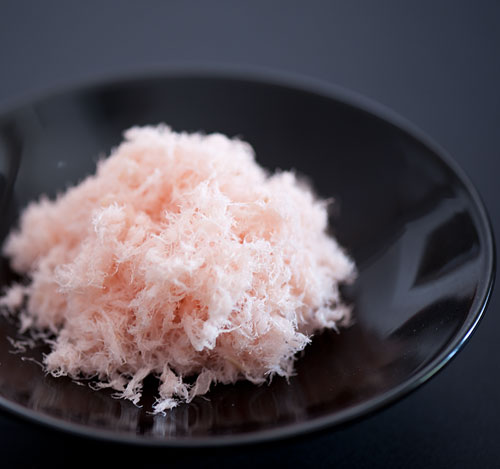
Sakura denbu (桜田麩) is a sweet-salty, fluffy pink flaked fish condiment - a sort of fish furikake - that is used in sushi rolls as well as to decorate various rice dishes. It's used quite often in spring, because of its dainty appearance and cherry-blossom pink color. (Sakura means cherry blossom or tree.) You can buy it in little packets at any Japanese grocery store, but commercial sakura denbu usually has MSG and various preservatives in it. Plus, it's rather expensive at my local Japanese grocery store. So, here's a homemade sakura denbu recipe to use in your springtime bentos.
It's not that difficult to make, but there are some key points to pay attention to to produce the desired fluffy texture, so I've included a lot of procedural photos. Make sure to choose a fairly low-fat white fish for this; a high fat fish like salmon will clump up and not produce the fine flakes that are characteristic of denbu.
Recipe: Sakura Denbu
Makes about 1 1/2 cups
- 300 g / 10.5 oz fresh cod or other flaky, low-fat white fish, skin and bones removed
- 1 5cm (2 inch) long piece of konbu seaweed, optional
- 1 teaspoon sea salt, plus extra for poaching the fish
- 3 tablespoons sugar
- 2 tablespoons sake
- 1 tablespoon mirin
- red food coloring
Equipment needed: small saucepan, non-stick frying pan, fork and/or cooking chopsticks, paper towels, kitchen towel
Equipment suggested: a stick blender
Cut the fish into pieces so that it fits comfortably in the pan. Put the konbu seaweed and the fish in the pan, cover with water, and add a pinch of salt. Bring up to a boil over medium-low heat, then turn down the heat to low. (The konbu can be omitted if you don't have it, but it adds a bit of extra umami.)
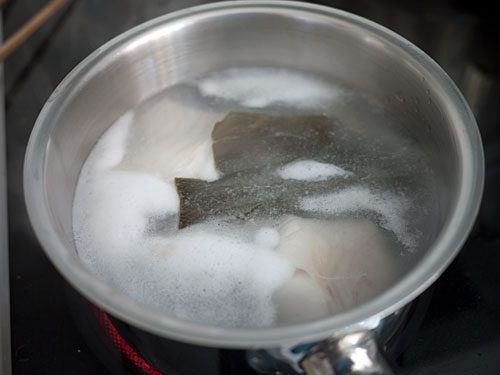
Scoop off the foam that rises to the top of the cooking liquid and discard. (This helps to keep the fish as white as possible when you flake it.)
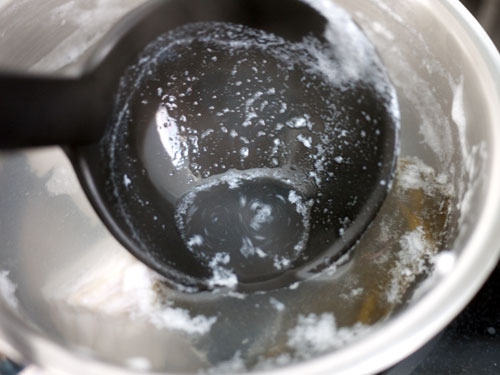
The fish is cooked when it flakes apart easily, like so.
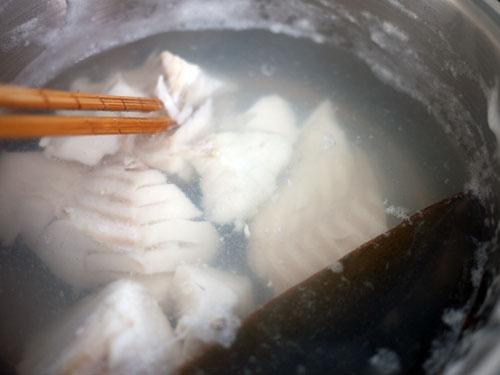
Drain the fish into a colander. You can keep the cooking liquid if you like to make soup.
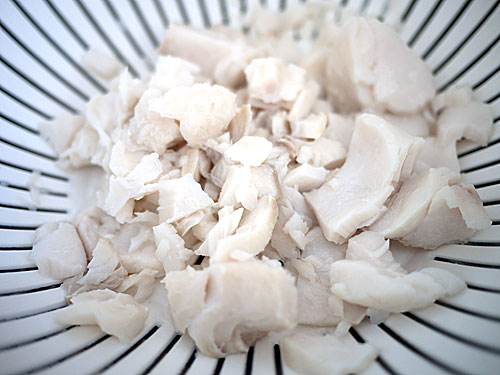
When the fish has cooled enough to handle, wrap it in several layers of kitchen towel and squeeze gently to take out a lot of the excess moisture.
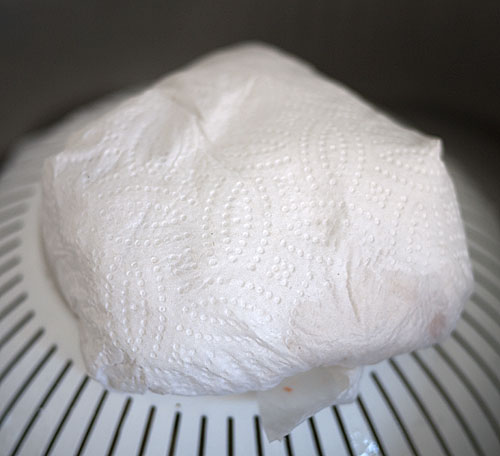
The squeezed out fish should look sort of like this. At this point, if you are fanatical about having snow-white fish flakes, remove any brown bits of fish. (I didn't bother to do so.) Inspect the fish carefully and remove any bones.
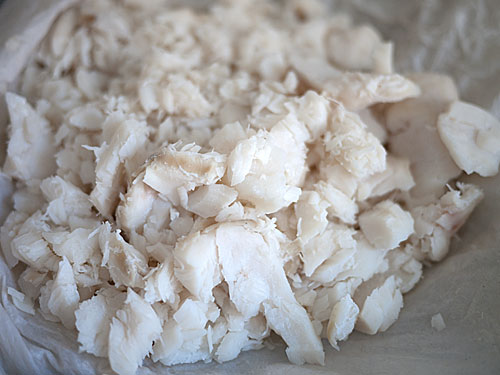
In the meantime, wash out your pan or use another, clean one. Moisten a kitchen towel with cold water, wring it out and fold it up; put it on the counter next to your stove.
Put the pan back on the stove over medium-low heat. Add the sake, mirin, sugar and 1 teaspoon of salt. Add the fish and start to mix vigorously with chopsticks or a fork.
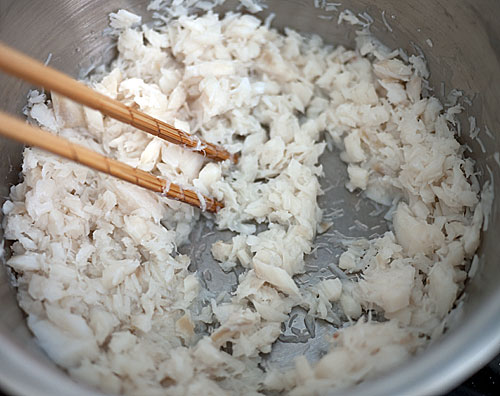
If you have a stick blender, you can use it to break up the flakes quickly. Be careful though and use a low speed if you can or the fish will go flying all over the place!
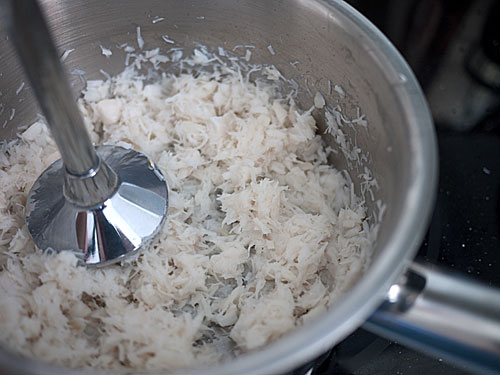
Keep on stirring with chopsticks (using 3 or 4 held together makes it go somewhat faster) to flake the fish, as the moisture evaporates. Use the stick blender again if you think it's necessary.
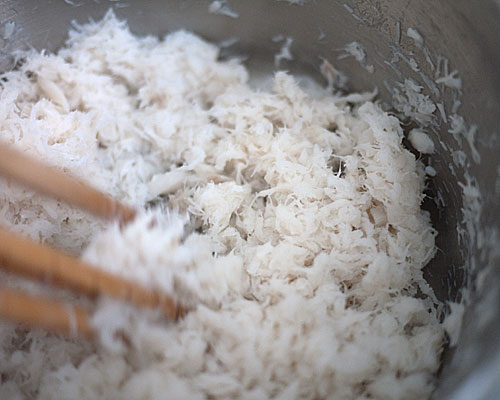
If the fish is sticking too much to the bottom of the pan, it's probably gotten too hot. Cool it down by pressing the bottom of the pan very briefly on the wrung out kitchen towel, and lower the heat a bit.
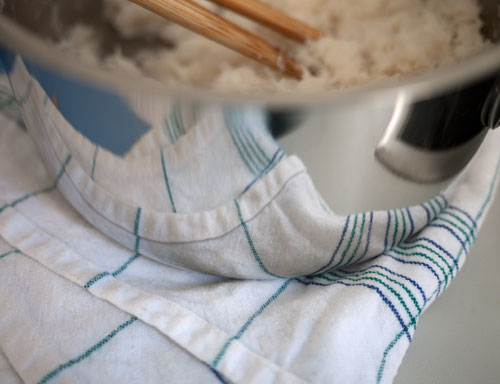
After a few minutes, you'll have a fluffy, silky mass of fish flakes, like so. Taste it and add a bit more sugar or salt if you think it needs it.

Coloring the fish flakes
You can leave the denbu in its natural white state, but the 'sakura' part of the name comes from the pink color. I've experimented with red cabbage and other natural food colorings for this (see Natural ways to make your bento colorful, and all natural green, pink and orange rice) but I found it difficult to make the fish the desired pink color without adversely affecting the flavor. I thought about using ume vinegar, but I didn't want the fish to turn too sour. So I've used a little bit of food coloring here - commercial sakura denbu uses food coloring after all - but I make it a much paler shade of pink, the color of the most popular kind of cherry blossoms. You may want to seek out 'all natural' food dyes if you are particular about not using artificial dyes at all. Of course, you can make it much pinker, or dye it any color you like.
To add color to the flaked fish, dissolve a little food coloring in some water, and add to the pan. Mix rapidly to distribute the color evenly. Add a little at a time - you can always add more but you can't take it out! (Note that I've switched to a non-stick frying pan, because my fish got a bit brown on the bottom in the saucepan!)
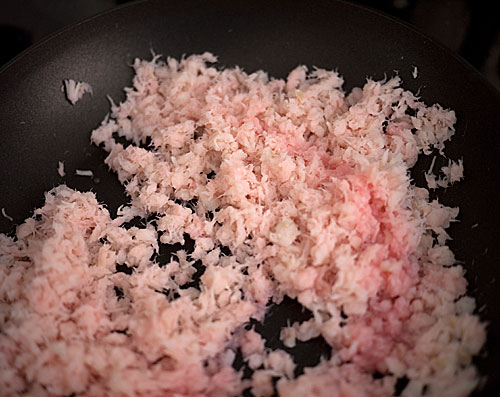
The fish flakes will clump up again, so resume mixing and flaking as before. A fork is good for breaking up stubborn clumps. (By the way, I add food coloring after the initial flaking is done, because the color spreads more evenly that way and is a bit easier to control.)
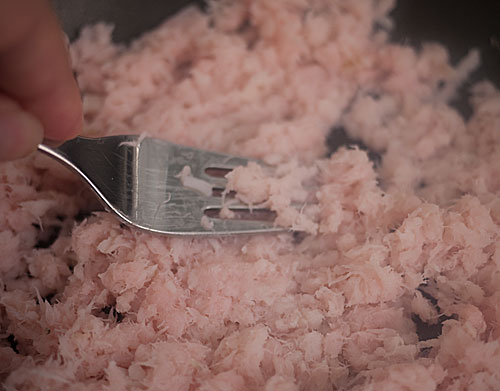
Keep stirring the fish until you end up with a finely flaked mass, that should look like this.
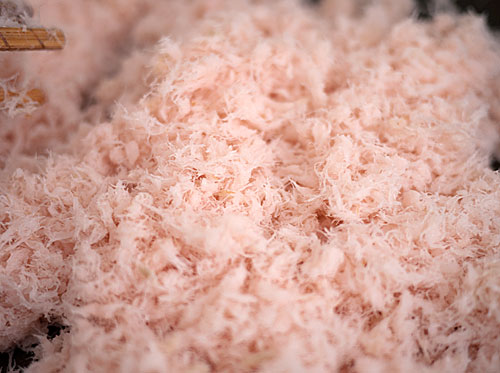
Properly made denbu looks like fine, silky threads that just came off a cocoon.
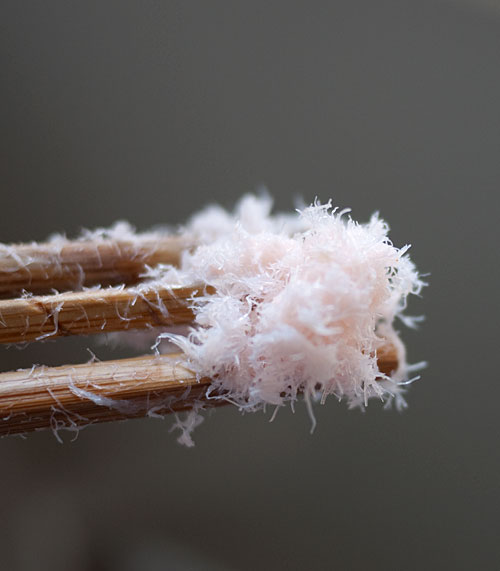
Storing denbu
Store sakura denbu in an airtight container. It will keep for about 2-3 days in the refrigerator. You can also freeze it, and take out as much as you need by scraping it off with a fork. Microwave it for a few seconds to regain that fluffy texture.
About the sake and mirin
You can leave out the sake and mirin if you don't have them. They help to make the fish taste less 'fishy' and improve the flavor however. (See this post.) If you don't have sake or mirin but are looking for an alcohol with similar properties, you can substitute 2 tablespoons of Chinese xiaoxing wine, or dry sherry. You may need to add a bit more sugar or other sweetener too. See The role of alcohol, onion and ginger in Japanese meat (and seafood) dishes.
Update: a bento that features sakura denbu.
If you enjoyed this article, please consider supporting this site by becoming my patron via Patreon.
